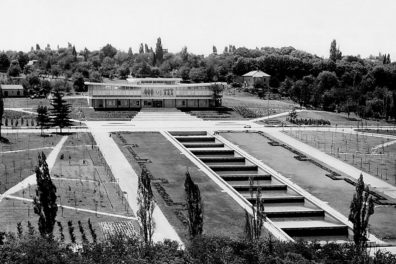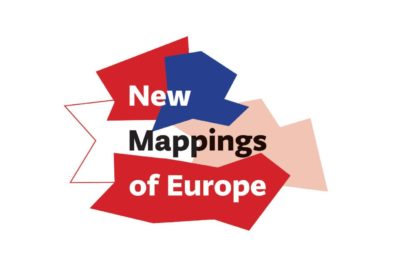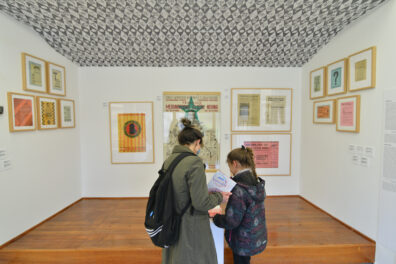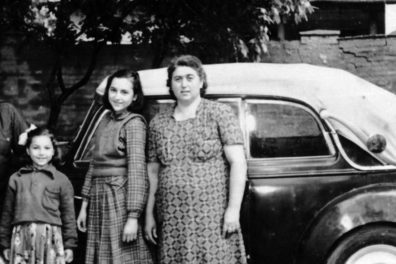
REMEK DELA NA GOSTOVANJU – Pozajmice iz likovne zbirke Muzeja Jugoslavije u 2024. godini
The art collection of the Museum of Yugoslavia, as well as the entire collection of the Museum, comprise two collections: The Collection of gifts – fine art from the collection of the Memorial Centre and the Collection of fine art works of the Museum of the Revolution.
The considerably larger art collection of the Memorial Centre (over 5,000 items) is very specific as it has not been created in a systematic program of collecting, purchase or exchange, and it mostly comprises gifts presented to Josip Broz Tito. The donors have been various social and political organisations, common citizens, famous artists, but also presidents and other foreign officials. Hence, a valuable art collection has been created, which represents a unique global museological and cultural phenomenon. Although it has been collected unsystematically, the number and diversity of the items show a good cross-section of Yugoslav art of the 20th century.
In contrast to the unsystematically created art collection of gifts presented to Josip Broz Tito, the art collection of the former Museum of the Revolution of the Yugoslav Peoples has been created with a clear vision to illustrate the ongoing revolution, from the works depicting the plight of workers before the World War I and socially engaged art of the interwar period, through war art and the partisan genre to socialist realism and works of art representing the construction of the country after the World War II. It was largely created by acquisitions, with a clear thematic orientation to use the works of art to “revive” and bring historical events from the late 19th century to the 1990s closer to museum visitors, emphasizing the idea of socialism.
Following the two-decades-long work on processing, systematizing, photographing, publishing and cataloguing the abundant art material from the collection of the Museum of Yugoslavia, the art works of the museum collection have become most frequently requested items to be borrowed, used for publications and research by colleagues and institutions from the country and abroad, mostly from the region of the former Yugoslavia.
The departure of the items from the depot and their display at exhibitions in other institutions, and most often their publication in the accompanying catalogues of those exhibitions, gives them an additional value, and the Museum popularises and promotes its collection outside the institution walls. Thus, the audience that might not come to the Museum, gets to know the Museum’s heritage and discovers in what ways the museum collections can be interpreted.
It is also significant that when items are temporarily borrowed, before each new display of the cultural property, the items must be inspected in detail by a conservator and, if necessary, the conservation and restoration must be carried out. Most often this journey of items brings about an additional benefit, as some research is carried out on such occasions, and some new information is obtained about the work of art, its author or the context of its creation.
Nejc Slapar, Galaxy, 1976
For the purpose of a group exhibition of Slovenian artists related to optical art and geometric abstraction, reconstruction of one of the largest drawings in the former Yugoslavia has been carried out. Due to the monumental format of the work, the reconstruction was done in the premises of the May 25 Museum in front of the audience. During the preparation for the conservation, the artist, who unfortunately died only a month later, had made a statement about the context of the creation of the work, the technical details and the way he had presented the gift to the then president of the state.

Nejc Slapar (1945–2024) Galaxy, 1976, Ink drawing on cardboard, 2.17 x 10 m, A gift from the artist to Josip Broz Tito, 1976
Exhibition: Extended view, Cukrarna Gallery, Ljubljana, February 15 – May 26, 2024
Jovan Kratohvil, A Pioneer Courier, 1946, Composition 8/64 “The presence of death”, 1964
Both sculptures have underwent conservation. The conservation has been performed by a conservator of the Museum of Yugoslavia, a conservator of the National Museum of Serbia and the son of the author of the sculptures, a sculptor himself, Marko Kratohvil.
A major surprise for expert public was the sculpture Pioneer Courier made by sculptor Jovan Kratohvil in 1946, which has been considered lost for decades – even by the author himself. Scholars believed that this plaster sculpture either perished, since plaster is a sensitive material, or ended up in an institution outside Belgrade, or that it has been simply lost. However, it has been there all the time in the Museum’s depot in the Collection of fine art works of the Museum of the Revolution, the collection owned by the Museum of Yugoslavia. We at the Museum have been surprised that it was Jovan Kratohvil who presented to Marshal Tito the rifle that we have keep in the Collection of Weapons and Military Equipment, and which had won him the silver medal at the World Championship in Argentina in 1949, where he represented Yugoslavia.
Jovan Kratohvil (1924–1998), A Pioneer Courier, 1946, plaster, 116.5 x 35 x 57 cm, Taken from the Federal Executive Council, December 12, 1966
Jovan Kratohvil (1924–1998), Composition 8/64 “The presence of death”, 1964, steel, brass, 42 x 42 x 35 cm, A gift from the Security Authorities to Josip Broz Tito on the occasion of the Day of the National Security Service, May 9, 1977
Exhibition: Jovan Kratohvil – Composition 100/24, National Museum of Serbia, November 15, 2024 – January 26, 2025
Ana Vidjen / A Starry shape, 1965
The sculpture has been exhibited for the first time and is the only institutional loan at this exhibition, which testifies to its importance. The plan is to record the author’s statement for the Museum’s audio archive. This is particularly important to us because Ana Vidjen, who is 94 years old, is the co-author, with her husband Nikola Kolja Milunović, of the monument to the victims of Nazi terror in the Banjica concentration camp in Belgrade. It is our wish to contribute to the popularisation of Yugoslav female artists in line with the values of female emancipation and equality that we as an institution stand for.

Ana Vidjen (b. 1931), A Starry shape, 1965, Bronze, 40 x 30 x 25 cm, Purchased from the author, May 14, 1970
Exhibition: A trace as a record and a symbol – Ana Vidjen, Museum of Contemporary Art, Belgrade, December 16, 2024 – February 24, 2025
Аleksandar Deroko / The scetches from the Banjica camp, 1941
On the occasion of the 80th anniversary of the liberation of Belgrade from German occupation, the Museum of Genocide Victims has borrowed as many as 12 drawings by Aleksandar Deroko, who was arrested in November 1941 with a large group of Serbian intellectuals, communists and freemasons and taken to Banjica, where he spent three weeks. When we talk about works of art created in the concentration camps, the most numerous are the drawings of Aleksandar Deroko in the collection of the Museum of Yugoslavia. It is particularly important to us that this exhibition has widened the knowledge about the works and enabled a better contextualization, but also drew attention to their value, in line with the intention of the Museum of Yugoslavia to declare the works of art about the suffering in Nazi camps together with documentary material and personal items, a cultural asset of great importance as a whole, that has great not only artistic, historical, cultural, but also symbolic value.

Nadežda Petrović, Landscape II, undated


Nadežda Petrović (1873–1915), Landscape II, undated, oil on cardboard, 38 x 53.5 cm, Gift of the city of Čačak to Josip Broz Tito, September 24, 1959
Exhibition: Nadežda Petrović – Colours of Life, Museum of Contemporary Art, Belgrade, February 14 – May 12, 2024

The Origins: The Background for Understanding the Museum of Yugoslavia
Creation of a European type of museum was affected by a number of practices and concepts of collecting, storing and usage of items.

New Mappings of Europe

Museum Laboratory
Starting from the Museum collection as the main source for researching social phenomena and historical moments important for understanding the experience of life in Yugoslavia, the exhibition examines the Yugoslav heritage and the institution of the Museum


